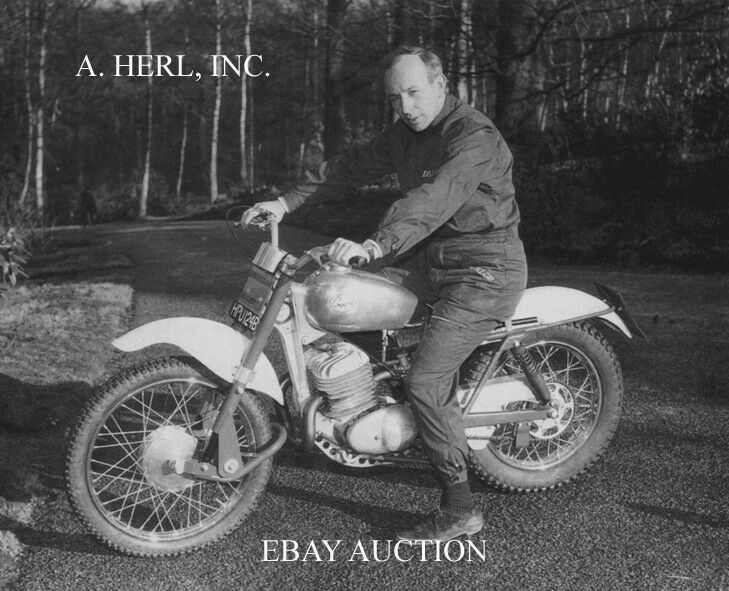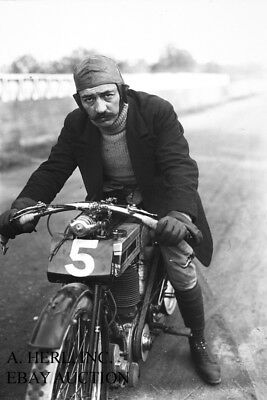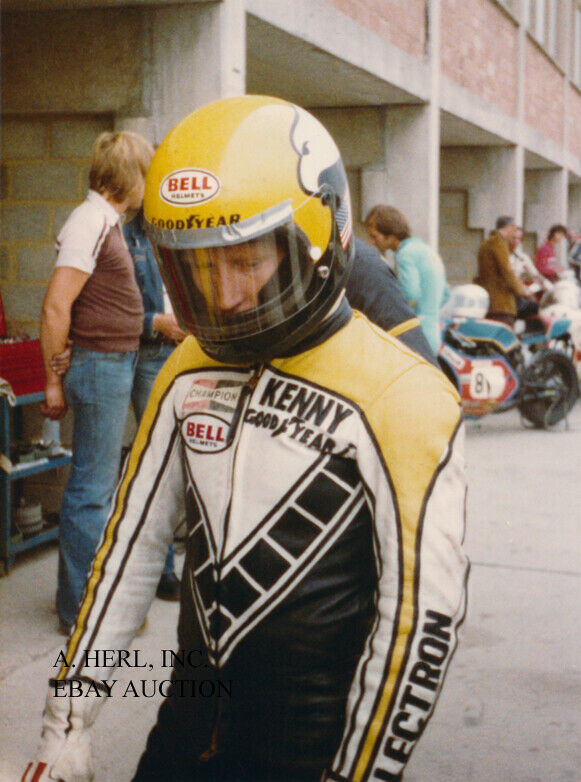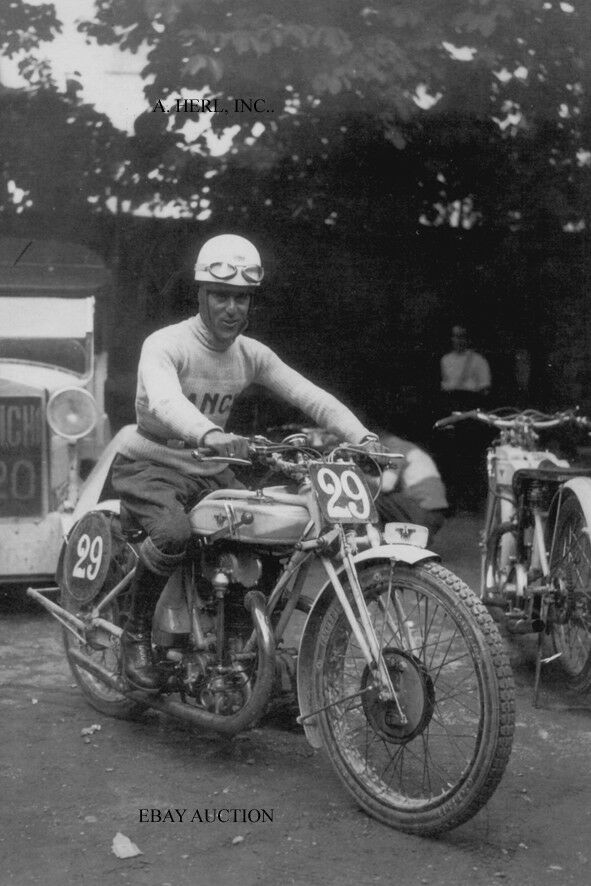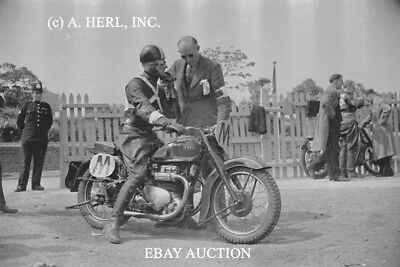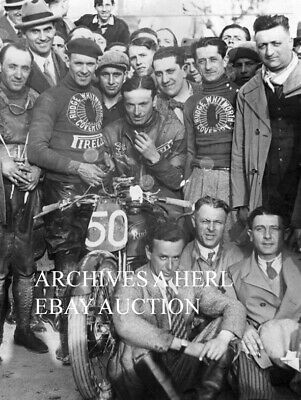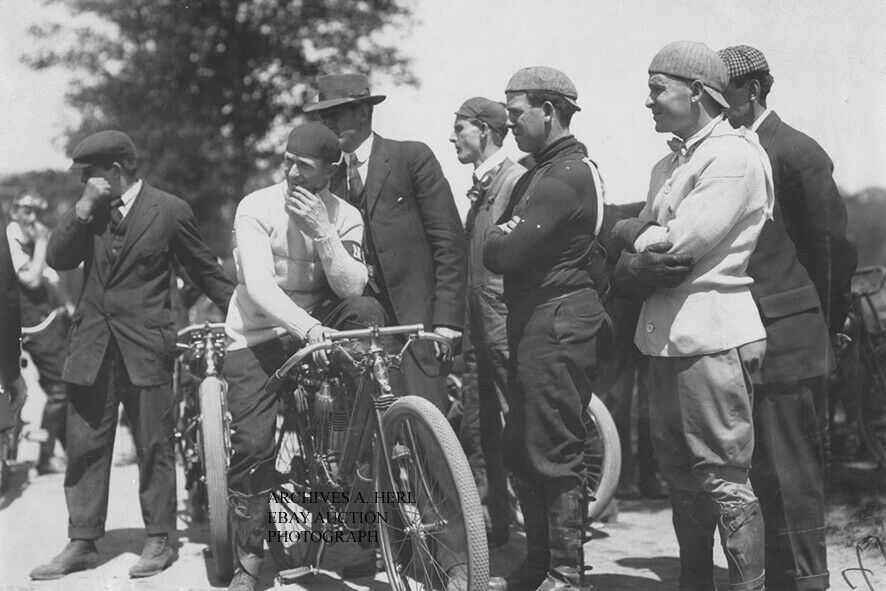-40%
Ossa 250 Grand Prix & Herrero – German GP 1969 - photo motorcycle racing sport
$ 5.14
- Description
- Size Guide
Description
A superb and rare photo of the magnificentSantiago Herrero
, in action with the amazingly successful 249cc
Ossa 250 Grand Prix
monocoque factory racer during the
West German Grand Prix
, which was ridden on the circuit of
Hockenheim
on the
May 11, 1969
.
Unfortunately Herrero retired during the race, however that year he would
win
the 250cc Grand Prix races in
Spain
,
France
and
Belgium
. This was enough to finish 3RD in the world championship 250cc that year, behind world champion Kel Carruthers (Benelli), Kent Andersson Yamaha, 2ND). Renzo Pasolini finished 4TH , like Carruthers also on a Benelli four cylinder worksracer. Andersson had beat Herrero with just one point!
The Ossa 250 GP had a single cylinder 249cc engine with a bore and stroke of 70 x 65 mm. The massive looking disc valve engine was fed by an equally massive 42mm Amal GP carburetor. Its power output was with 42 bhp at 11,000 rpm rather impressive. No wonder it did so well during many Grand Prix, International and National road races all over
Europe
! The frame of the Ossa 250 GP was of a truly magnificent
monocoque
design, extremely stiff it assured magnificent handling!
At the age of 12
Santiago Herrero
, born in the Spanish city of
Madrid
in 1943, bought his first motorcycle. In 1962, he obtained his racing license, competing on a Derbi and doing his own maintenance. He soon moved up to a Bultaco Tralla 125 and caught the eye of Luis Bejarano, the owner of Lube (a Spanish motorcycle marque) who recognized Herrero's talent. Bejarano offered him a job in the company's competition department. In 1964, Herrero finished in third place in the 125cc Spanish National Championship and in 1965, he finished in second. Unfortunately, the Lube marque ran into financial difficulties and went out of business. Herrero decided to go into business for himself, running a motorcycle repair shop in
Bilbao
. He purchased a Bultaco and competed as a privateer. Around this period, Eduardo Giró, lead designer of the Ossa motorcycle company developed a revolutionary bike with a monocoque chassis. Recognizing Herrero's riding talent as well as his mechanical skills, Giró offered him a job to develop the Ossa 250cc race bike. Together they won the 250cc Spanish National Championship in 1967. In 1968, he would move up to compete in the 250cc Grand Prix world championship. Although the single cylinder Ossa had 20 HP less than the powerful V4 Yamahas of Phil Read and Bill Ivy, the Ossa was 45 pounds lighter and its monocoque frame was much stiffer, giving it superior agility. The Yamahas swept the championship but, Herrero left no doubt that the little Ossa was quick and dependable. He finished seventh in the championship and claimed a third place in the final race of the season at
Monza
. He would once again take the 250cc Spanish National Championship. 1969 would be a big year for Herrero. He began the year winning his first Grand Prix at the opening race of the season in front of his countrymen at Jarama. After retiring from the German Grand Prix with mechanical problems, he returned with a victory at
Le Mans
. He followed this with third place at the Isle of Man TT, a considerable accomplishment considering his horsepower deficit on the infamous Snaefell Mountain Course. He triumphed again at Spa and was leading the championship points race when he was beset by bad luck. He crashed in the rain at the Ulster Grand Prix and suffered a broken left arm. Most observers considered his championship hopes dashed, but Herrero showed true grit by coming back to finish in a remarkable fifth place at Imola. At last race of the season in
Yugoslavia
, he held a one point lead in the championship. He started the race in the lead but crashed on the seventh lap, ending his championship hopes. He would finish third in the World Championship. He repeated as Spanish 250cc champion for a third consecutive year. Herrero got the 1970 season off to a promising start. Although, he retired from the first race of the season in
Germany
, he finished in second in
France
and took a victory in
Yugoslavia
. The Grand Prix circus then moved to the
Isle of Man
, where Herrero was tragically killed during a crash. The cause of the accident was described by Stanley Wood as "may have been melting tar on the bend." He was 28 years old. His loss affected the Ossa factory so much that they abandoned racing altogether.
Spain
had lost one of their first racing heroes.
Ossa
, a Spanish motorcycle manufacturer which was active from 1924 to 1982, was best known for lightweight two-stroke-engined bikes used in Observed Trials and Motocross. Ossa stands for Orpheo Sincronic Sociedad Anónima (O.S.S.A.), the company that later was renamed into the Maquinaria Cinematográfica, S.A., founded by Manuel Giró, an industrialist from
Barcelona
. The Ossa brandname was still used. The brand still remains popular around the world, and particularly in the
United States
, among enthusiasts from amateurs in historic motorcycle racing to hobbyists and collectors. The original Ossa company got its start in 1924 making movie projectors for its home market in
Spain
. After World War II, with improved two-stroke-engine technology obtained by the Allies from DKW in
Germany
, Ossa, like several other manufacturers from BSA to Harley-Davidson to Yamaha, began producing two-stroke engined motorcycles, with their first mass produced model being introduced in 1949. Ossa reached its highest production levels in the motorcycle boom of the 1960s, exporting large numbers of exports to other European countries, but also significantly, to North American markets. In the
United States
and
Canada
,
off-road motorcycling - and particularly the newly imported sport of motocross to which the light-weight and powerful Ossa was well suited - enjoyed a surging popularity. The Stiletto 250 in particular was a common sight to see in motocross races as well as motorcycle trails, during its heyday of the late 1960s and early 1970s. The Ossa firm was a strong supporter of all forms of motorcycle sport including: road racing, motocross, enduro and observed trials. They achieved early success in Grand Prix road racing, competing with an innovative monocoque-framed bike
(SEE PHOTO!)
designed by Giró's son, Eduardo and ridden by Santiago Herrero. Herrero won four 250cc Grands Prix with Ossa before he died while competing at the 1970 Isle of Man TT. The loss of their star rider affected the Ossa team so much that they withdrew from road racing altogether. However, Ossa contributed greatly to the sport of Observed Trials (chich has come to be regarded as almost a Spanish national sport) in
Europe
and the
United States
alongside such other famous Spanish makes as Bultaco and Montesa. They turned to observed trials after the death of Herrero. Ossa hired British rider Mick Andrews to help design and ride their trials bike, and they went on to capture the 1971 and 1972 European Trials Championship, the forerunner to the FIM World Championship. In addition to their suitability for racing, in terms of power-to-weight, Ossa motorcycles soon gained a reputation for reliability on and off the track. Despite this growing enthusiasm for the beautifully crafted and rugged bikes themselves, the firm suffered from a disorganized and sparse dealer network in the important American market. Ironically, the motorcycle boom that created a new market and allowed the European makes to reap great financial rewards, was also the seed of their own demise, and that of the numerous smaller firms, such as Ossa. With so many choices of make for both buyers and dealers, sales and service networks were not sustainable, and attempts to improve manufacturing by investing in new factories back home, put Ossa, like virtually every other European firm, deep into the red. In the declining years of the Franco Era, in 1975, the Spanish government steadily converted
Spain
's economic structure into one more closely resembling a free-market economy. The arrival of cheaper Japanese motorcycles into the local economy as well as a crippling employee strike in 1977 spurred the downfall of the Ossa company. In 1979, the company merged with Bultaco but this wasn't enough to stave off financial problems. By 1982, the Ossa factory closed down for good. Nonetheless, as a Vintage make, the Ossa still enjoys a significant following among home hobbyists and amateur racers. Ossa manufactured the following models: Copa 250 (Street)* Desert Phantom (Motocross/Trail) * Explorer (Trials) * Formula 3 (Street) * Gripper (Trials) * Mick Andrews Replica (Trials) * Mountaineer (Enduro) * Phantom (Motocross) * Pioneer (Enduro) * Plonker Trials) * Sport 175 (Street) * Super Pioneer (Enduro) * Six Day Replica (Enduro) * Stiletto (Motocross) * Stiletto TT (Flat Tracker) * Turismo (Street) * Wildfire (Street) * Yankee (Street). Interestingly, the Yankee motorcycle, manufactured by the Yankee Motor Company, uses Ossa engine components. The company was started by John Taylor, a long-time resident of that area. The motorcycle used an Ossa engine. The engine was a unique combination of two Ossa cylinders, that produced a twin-cylinder engine of near 500 cc capacity. The Yankee frame and running gear were produced in the
US
, and the entire motorcycle was assembled in the Yankee plant in
Schenectady
.
We have more photos listed on Ebay, also motorcycle (racing) photos! Check them out and use the shipping discount!
This is your rare chance to own this
non period
photo that reflects a very interesting and historic piece of motorcycle and Ossa history. Therefore it is printed in a nice large format of ca. 8" x 8.3" (ca. 20 x 21 cm).
Shipping costs will only be $ 7.00 regardless of how many photos you buy. For 5 or more photos, shipping is free!
(Note: A. Herl, Inc. does not appear on photo, for ebay purposes only)
No copyright expressed or implied. Sold as collectable item only. We are clearing out our archives that we have gathered from various sources.
All items always sent well protected in PVC clear files
and board backed envelopes.
We have photographs that came from professional collections and/or were bought from the original photographer or press studio! They are all of professional and excellent quality.
After many decades of professionally collecting photographs and posters we are clearing out our archives. They make the perfect gift and are perfectly suited for framing. They will look gorgeous unframed and will be a true asset nicely framed with a border. They are a gorgeous and great asset in every home, workshop, workplace, restaurant, bar or club!
First come - first served. And you can always contact us for your requests. Please ask any questions before the auction ends.

